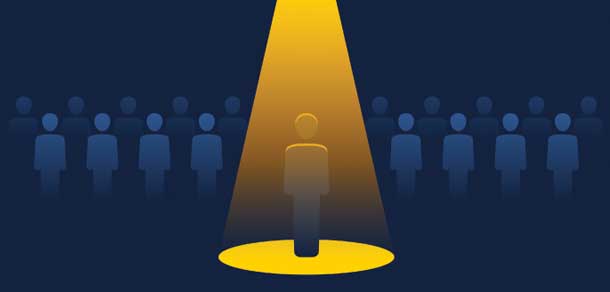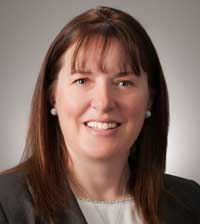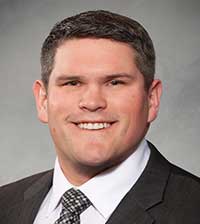APEGS has two firsts within the group of four executive members of council: President-elect Kristen Darr, P.Geo., as APEGS’ first female president-elect geoscientist and John Desjarlais, P.Eng., as the first Indigenous vice president in an engineering and geoscience regulatory association in Canada. Of course, there are many qualities that make Kristen and John unique, as you will read below.
Kristen Darr’s, P.Geo. future will make history
In May 2020, Darr assumed the role of APEGS’ president-elect. One year from now, when current president Andrew Lockwood’s (P.Eng, FEC) tenure ends, Darr will transition into that role.
With it, Darr will become the first female professional geoscientist to serve as APEGS president.
That was news to her. She wasn’t aware of that fact until after she was voted in.
“Yes, it’s important. But I don’t dwell on it,” Darr said. “I do take it seriously in knowing that it will be one for the record books and there will be a lot of people who see that. It’s a real positive.”
“Whether you’re a P.Geo. or a P.Eng. or both, male or female, the president role is significant. There’s a lot of time and effort that has to be given by that individual. That doesn’t change based on your professional background. When you have a P.Geo. versus when you have a P.Eng. or male versus female, you get different perspectives. That’s what excites me the most about the role.”
Darr is the Director of Health, Safety and Environment with SaskEnergy. She is responsible for the corporation’s safety and environmental management systems.
Networking is a big component of Darr’s professional life. It has proved beneficial in her volunteering endeavours as well. She didn’t hesitate to reach out to familiar faces like Ernie Barber, P.Ag,, P.Eng., FEC and SaskEnergy CEO Ken From, P.Eng., FEC – two men who previously held the title of APEGS president – to glean their knowledge and experiences.
Darr volunteered with APEGS committees prior to joining council, on which she served from 2015-18. She felt those experiences helped develop a good base for what she’s getting into.
“I felt that personally and career-wise I could benefit by being on council,” she said. “Volunteering at APEGS at this level would give me a perspective I haven’t been exposed to. I’m the type of person who likes to continually learn and gather other perspectives and network with other people in other areas of business. This was a great opportunity for that.”
Her experiences have been positive, which is why she let her name stand for president-elect.
“It’s the year before I take on the biggest responsibility as president. It’s a very big honour and you realize it’s time to learn and time to get to work.
“This is my year to learn and to understand because this role, in my mind, is prepping for next year and taking on that bigger responsibility and to do it in a way that makes me proud in what I’m doing and to provide value to APEGS as well.”
Darr prefers listening over talking, but don’t confuse that with being passive. She’s more than capable of sharing her perspectives and knowledge and feels her roles this year and next are ones in which her voice should be heard.
“You need to listen to council and you might be the chair of the meetings, but you shouldn’t be doing all the talking,” she said. “You should be listening and guiding the conversation and have the ability to guide through the discussions and get to a point of making decisions.”
Darr did not campaign for the president’s role on a specific platform, nor does she have a set agenda for when she assumes the chair next spring.
She said she is a strong promoter of the governance review and where it will lead APEGS in the future.
“I want this to be successful for APEGS,” she said. “There are huge benefits to what we’re doing. It helps us understand the big picture and it allows council to have all of the information to make the right decisions.”
“We’ll be dealing with staff and volunteer structure and we have to take those very seriously. We have to make decisions that are best for APEGS, but there’s a human component too and that has to be understood.”
Prior to SaskEnergy, Darr began her career in the consulting industry, primarily working in environmental and geotechnical areas. She built a foundation of experience travelling throughout northern Alberta and Saskatchewan conducting field work. This foundation allowed her to take on the responsibility of a variety of major projects as an environmental geoscientist and project manager later in her career.
She obtained her degree in geography and environmental studies from the University of Victoria.
John Desjarlais, P.Eng. persevered into VP role
John Desjarlais spent every chance he could of his childhood whizzing around Cumberland House, his hometown, on a snowmobile and a motorized fishing boat.
His genuine curiosity for how these machines ran fascinated him. He found himself taking apart engines and putting them back together.
Couple that with a gentle push from his parents – his father John Sr., worked a variety of roles in the mining industry and his mother Rhonda challenged him academically and encouraged him to be creative and innovative – and that is what led Desjarlais to pursue a post-secondary education.
Engineering, however, came later.
“I didn’t identify or relate to engineering,” he said. “It was something that was a really abstract concept at that point. I didn’t know any practitioners or professional engineers. It was really challenging for me to even think about.”
At 21, Desjarlais had more of an interest in environmental science. He studied that and found work at Cameco as a junior radiation technician. That’s where his real exposure to engineering was found and it inspired him to return to school.
Desjarlais eventually graduated in 2011 with a mechanical engineering degree from the University of Saskatchewan.
Fast forward to May 2020 and the soon-to-be 40-year-old is now APEGS’ vice-president, one of the few Indigenous engineers in such a role for a Canadian engineering regulator.
“I’m very proud that I’m able to grow within the organization,” he said. “I’m proud that this is something voted on by the members. The community voted me in knowing my background and knowing who I am and what I’ve done. That really means a lot.”
“That affirmation from my peers, that respect from my peers, makes me feel very proud. It helps me realize that I made the right choice. All of that doubt is gone.”
The doubt Desjarlais refers to comes from his youth and not being able to identify with Indigenous people in engineering.
“There’s this doubt that creeps in and you ask yourself if you can succeed,” he said. “It’s almost like a self-imposed racism. You start to believe that you lack something that prevents you from succeeding in this occupation. As I grew older, I realized that was just a self-imposed barrier and something that was just plain wrong.”
Desjarlais quickly forged his path with APEGS and became immersed in several initiatives. Originally, he became involved with the Indigenous sub-committee and the Equity and Diversity Committee and the Indigenous sub-committee. Through these, he was able to champion the creation of national and regional organizations with a purpose of increasing awareness and participation of Indigenous people in STEM.
Desjarlais now serves as co-president of the first professional Canadian Chapter of the American Indian Science and Engineering Society; Society, Sask.caISES, which organized .caISES2020 – the largest gathering of Canada’s Indigenous STEM professionals and students in Saskatchewan.
“I wear my Indigeneity on the outside,” he said. “I speak very proudly of it. It is absolutely who I am and it’s where I came from.”
“It breaks my heart when I see people that I can identify and relate with that are overcome by a lot of the issues that we can certainly overcome if we make things more accessible.”
In addition to the Inclusion and Diversity Committee, Desjarlais also serves on APEGS council for the 2018-2020 term, the APEGS Professional Development Committee, the Education Board and has served on the Image and Identity Board and the K-12 Committee.
“When I first started, I was very passionate as a regulator,” he said. “How do we increase the awareness and participation of Indigenous people in our professions? As I got to learn more about the organization, I became involved in a lot more and offered my perspectives in good governance and self-regulation. Our responsibilities to the public really aligned with my values.”
As an aside, Desjarlais earned a non-profit governance certification and serves on a variety of boards and offers his experience and leadership to help serve his community.
As a student at the U of S, he worked as a sessional lecturer for the College of Engineering and volunteered as a mentor with the university while he completed his Master’s in business administration from the Edwards School of Business. He is working to finish a second Master’s in Governance and Entrepreneurship and Northern and Indigenous Areas through the Johnson Shoyama School of Public Policy.
Desjarlais is the general manager of Great Plains Contracting – a First Nations partnership that prioritizes sustainability and capacity development in delivering quality project and construction services.


